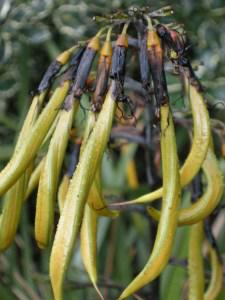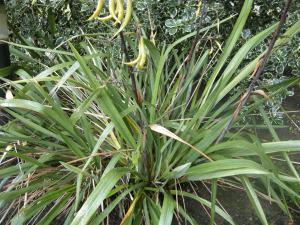
Phormium cookianum seed pod (24/07/2011, London)
Position: Full sun to partial shade
Soil: Moist, wet soil
Flowering period: Summer
Eventual Height: 2m
Eventual Spread: 30cm
Hardiness: USDA Zone 8a-10b
Family: Xanthorrhoeaceae
Phormium cookianum is an evergreen perennial with an upright habit. Its foliage is erect, sword shaped and dark-green with a central groove that runs the length of the leaf. In summer it bears panicles of tubular, hermaphroditic, pale yellowish-green flowers. These are followed by twisted, dark, almost black seed pods which ripen from green.
P. cookianum, commonly known to the Maori people as Wharariki and throughout the western world as Mountain Flax, is native to New Zealand. Traditionally this plant is used by the native people of New Zealand to weave baskets called kete. This plant was first known as Phormium colensoi in 1846. However this name was quickly superceded by P. cookianum as the previous name was not published for a couple of years and the new name was formally published and accepted as correct.
Phormium is derived from the Greek phormos meaning ‘basket’, with cookianum being named for Captain James Cook, the 18th century British navigator and explorer.

Phormium cookianum (24/07/2011, London)
This plant may be useful to the landscape architect as an evergreen perennial in maritime locations. It is tolerant of periodical flooding, even with saline water. It will tolerate short periods of drought once established.
The Royal Horticultural Society gave the cultivars Phormium cookianum subsp. hookeri ‘Cream Delight’ and ‘Tricolour’ their prestigious Award of Garden Merit in 1993.
This plant will tolerate almost any soil conditions; it will be happy at neutral, alkaline or acid pH levels, in loam or sand based soils, in a west, east or south facing, sheltered or exposed aspect.
Ecologically this plant will attract many species of pollinating insects such as honey bees and butterflies.
Maintenance: This plant requires little to no maintenance. Dead or damaged material may be removed in spring. Large clumps may be lifted and divided in spring.

